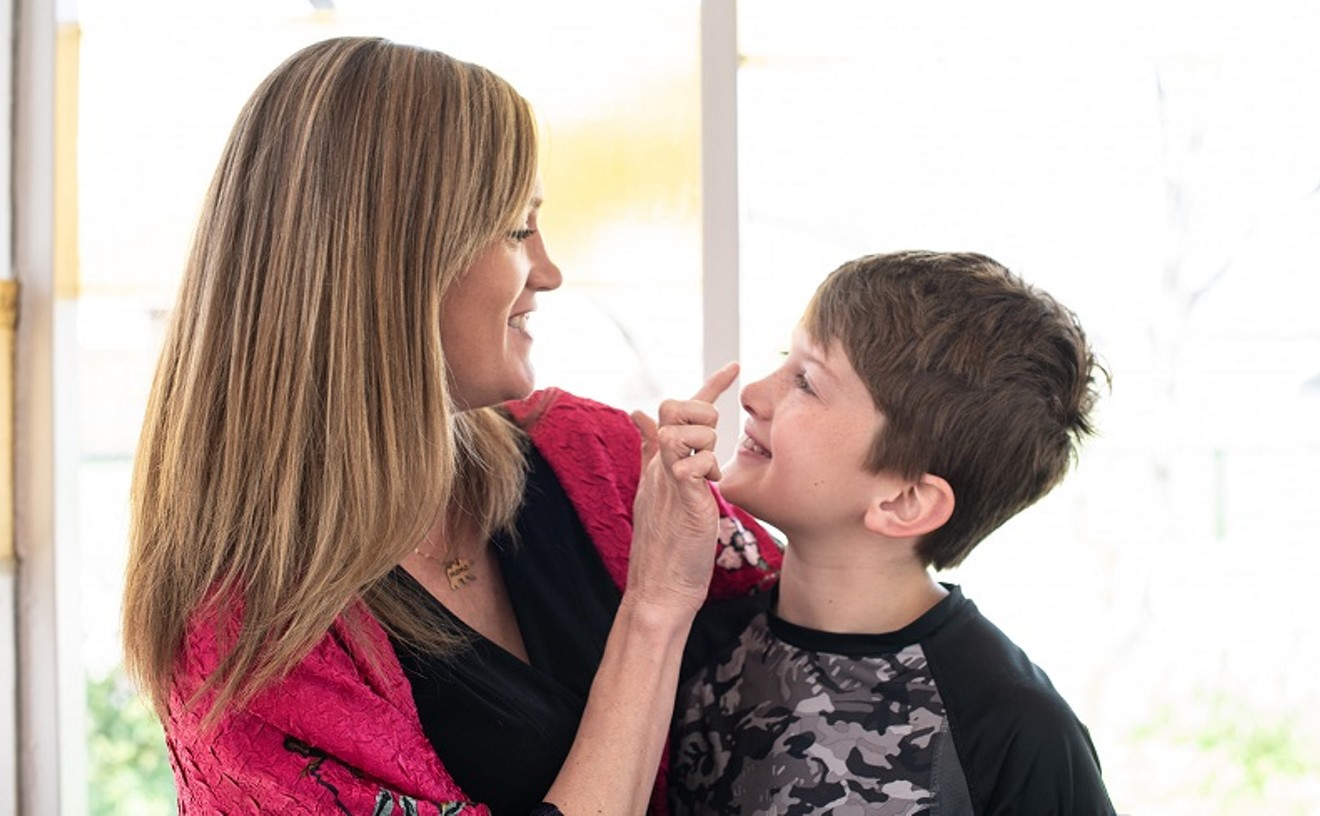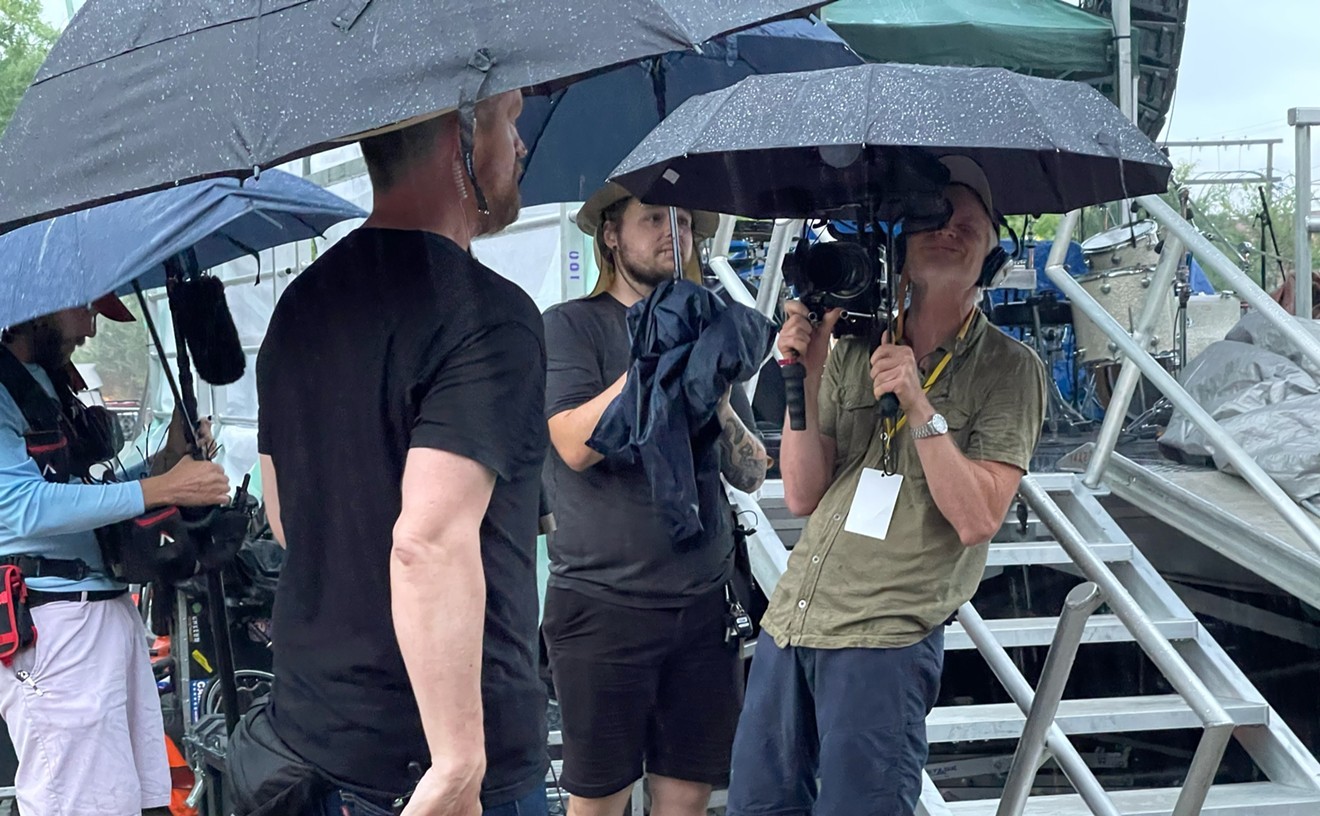"Oh, hey--did you see the Rev. Johnnie Swearingen piece in Tom's office? Really great." Or "I sure am digging this video installation in the stairwell. The swirling static and sparks have a calming effect on my nerves." And how satisfying to have a customer enter the foyer and immediately sound off at the receptionist, "What the hell are all those Styrofoam cups clipped together in a big igloo shape?"
It's art, invading the private sphere and doing what art does best: Confronting, confounding, inspiring, stimulating. Shaking things up. Just ask the person who put it there, curator Victoria Montelongo. "They love it. When the art's not up, the employees really miss it. A new show goes up, and they get attached to it. Then they get excited about what they hear will be next."
Montelongo is sitting on a sleek leather couch in the front room of Charlie's, so gracious and low-voiced, she seems to be at home. She knows every nook and cranny of the place and puts new art in them every chance she gets. To her right hang three undulating rubber wall reliefs by Kirk McCarthy, in all their fluorescent glory. To her left is a small sculpture by Tom Sale featuring a polar bear gazing earnestly at a woman behind a fence. Such fare is Montelongo's passion and business, and here, she makes it the business of a great many unwitting observers. "With so many clients coming through, the works get some great exposure."
Montelongo started curating in 1992, while still in graduate school at the University of North Texas. When AT&T reps came to the university art department looking for someone to spruce up their downtown Dallas offices, Montelongo got the gig. For three years running, she organized an annual show of local artists' work. Turns out she loved curating as much as she loves creating her own work, so in 1996, when CharlieUniformTango owners Lola Lott and Jack Waldrip asked Montelongo to put art in their new offices on an ongoing basis, she jumped. "It's a beautiful space. It's perfect for showing art. Great wall space, great floor space."
But more than that, she wants to break the expectation barriers between people and contemporary art. "I remember, when I went back to school and started studying art, the whole gallery scene terrified me," she admits. "It's intimidating. It can be pretentious and unwelcoming. I was scared to get out of my car. So I sympathize with people who won't go see art. Bringing art to them, to the place they work, where they don't normally see it, is gratifying. I hope to get them curious, to get them comfortable with it, talking about it."
Sure enough, every time Montelongo launches a new show, the opening party is packed. Employees and guests buzz around the entire space--with all its curving hallways and cozy sitting rooms and glassed-in offices; they look at the artwork and discuss it. They search out the artists and ask questions (a rarity at most gallery openings, where admitting ignorance is so uncool). This is a new world to many of them.
"First I brought in eight paintings by John Pomara. Some big ones," Montelongo says. "Second show was a group one--Monica Pierce, Tom Sime, and Mark Cole. Then the outsider art show." (This brilliant, sweeping thing included works by some dozen or more noted folk artists, all the pieces part of a private collection loaned to Montelongo.) "Then the Image Bank show, which was purely commercial." Montelongo works as an editor at the Image Bank, an international stock photo company. "I chose some of our more interesting photographs." And that one led up to the current show, titled a posteriori, a selection of works by emerging young artists, most of them based in Texas. "I mainly want to showcase new artists, contemporary art, and conceptual art. I wanna put unexpected things in front of people."
Unexpected, as in: a slender, 8-foot-tall tower of interlocking Legos, fortified by twine strung between pulley-like peripherals. Or a neat row of four tiny TV monitors, each just a few inches wide, showing scenes from a Brooklyn boxing gym--a sweating, panting pugilist punching straight at the camera, which looks pretty funny on such a diminished scale. These are works by Derrick Saunders, a local artist, and Alix Stewart Lambert, a prolific New York artist. Montelongo's connections run as wide as they run deep, but she'd much rather talk about the artwork than name-drop. She just loves this stuff. "Every time I get a new shipment in for a show, I'll open up a crate, and sometimes I'll just start shouting. I get so excited." Hard to picture such a thoughtful, poised person yelling out loud, but the spark in her eye tells me she's coming clean. She's onto something new, and she knows it.
It's the private as public, the public as private. Montelongo inhabits a Twilight Zone between gallerist and traditional curator. "Freelance curator" seems an appropriate title for her, though "hired art gun" or "quality-of-life enhancer" might work. Corporate art-buying is on the rise, but unlike the high-profile artwork purchased by Frito Lay or J.C. Penney as permanent collections for their lobbies (and often mapped out by a veteran museum curator), the art filling the walls and stairwells at Charlie can't be labeled collections, exactly. Charlie doesn't own this eclectic, varied stuff, and Montelongo breaks it up and moves it out to make room for new displays. Nor is this a conventional exhibition; the general public can't just waltz in and peruse the space, and even the "openings" are attended mainly by employees, clients, and press. Sure, some of it is for sale, but Charlie doesn't push to sell it; an interested employee or client has to contact Montelongo to get buying information. Owners Lott and Waldrip buy at least one piece from every group, as appreciation for and a record of what was once there, but Montelongo admits that this is hardly a money-making venture.
Yet artists are happy to contribute work, and at no charge. Not only do the employees enjoy the hell out of it, but dozens of clients working in creative industries also see it--far outnumbering those who would see it in most galleries. So from an artist's perspective, why not haul it out of storage or from the back of the studio and give it some spotlight? Many artists loan their works to friends to display in their homes between gallery shows, happy that their work has an ongoing audience. They know the Charlie office provides the same kind of low-key, high-potential sabbatical. It may not sell, but at least it's out there.
Granted, it may take a work environment as progressive as CharlieUniformTango to pull this off. There, pastries and gourmet coffee are served buffet-style each morning; all the furniture is future-sleek; employees kick back on the winding outdoor veranda circling the place; jeans and street shoes are the norm. Owners Lott and Waldrip can afford to up the creative-juice ante by hiring their own curator. But my guess is that this concept could be applied to many workplaces. As corporate psychologists and sociologists and efficiency experts continue to extol the virtue (read: productivity) of high employee morale, which comes by workers believing that the guys at the top actually care about them, the idea of art in the office makes perfect sense: "Hey, the boss just bought us a Warhol!"
When did art--and by that, I mean the whole visual shebang--leave our culture's everyday existence and enter the more exclusive realm of museums and galleries? For centuries in both east and west, people enjoyed artwork everywhere they went: church, the town square, civic centers, public parks, private gardens. Somehow this country has, aside from its scant war memorials and occasional stabs at public works, made art an elitist and specialized microcosm of interest. And that's the shame of it. Because regardless of your appreciation, the mere presence of artwork transforms a place from the mundane and everyday to an environment where expression and beauty and matters of the heart are welcome.
CharlieUniformTango may just be the most stimulating and healthy workplace in town. And it ain't the leather couch that makes it that way. It's that teeny polar bear behind the fence, and that Styrofoam igloo. Just ask the hired gun who put them there in the first place.










